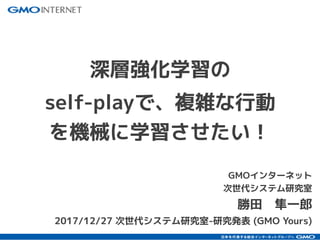深層強化学習の self-playで、複雑な行動を機械に学習させたい!
- 1. GMOインターネット 次世代システム研究室 勝田 隼一郎 2017/12/27 次世代システム研究室-研究発表 (GMO Yours) 深層強化学習の self-playで、複雑な行動 を機械に学習させたい!
- 3. 3 自己紹介 勝田 隼一郎 ? 大学時代: ボートに熱中しすぎ留年 ? 東京大学大学院理学系 研究科物理学 修了(博士) ? Stanford大学と広島大学で ポスドク(日本学術振興会; 高エネルギー宇宙物理学) 2016.4: GMOインターネット 次世代システム研究室 データサイエンティスト兼アーキテクト
- 7. 7 Outline 1. イントロ ? 深層強化学習とは ? Self-playとは(Alpha Goを例に) 2. 実験 ? 背景、セットアップ ? 実験結果、デモ ? 考察
- 8. 8 イントロ
- 9. 9 深層強化学習とは? 深層学習の技術を 強化学習という学習フレームワークに応用 ここでは強化学習について説明する。 深層学習については、強化学習のフレーム ワークを実現するのに便利な道具、と思って もらえば良い。 参考:「Deep Q-LearningでFXしてみた @ slideshare」 /JunichiroKatsuta/deep-qlearningfx
- 11. 11 機械は何を学習してる?(教師あり学習) input data output data 与えられたデータyに合うように パラメータを学習(人のアナロジー) モデル x f(x) = ax + b f(x) vs y f(x) = 1*x + 7 f(x) = 2.1x + 1.6
- 12. 12 機械学習とは 数式(モデル)= “機械”のパラメータを、デー タに合うように、最適化 = “学習”すること 深層学習も原理は全く同じ。 何か神秘的なことが起きているのではない。
- 13. 13 教師あり学習 vs 強化学習 例:無人島サバイバル 教師あり学習 “ツアー:無人島サバイバルを体験しよう! # 経験豊富ガイドがいるので安全です!” ? ガイド(教師)がいる。 ? 参加者(学習者)は、ガイドの言うとおりにす れば(正解データを真似すれば)、魚を釣り、 火を起こせる。サバイバルには困らない。
- 14. 14 教師あり学習 vs 強化学習 強化学習 = “リアルガチな無人島” ? 教師がいない。 ? 一人で行動し、その行動の結果から学習する。 ? 正解がわからない中で、”正しそう”な「方針」 を学ぶ。効率的な学習をしないと死んでしま う。。
- 16. 16 囲碁の場合 ? 状態: 盤上の碁の位置 ? 行動: 自分の石を一つ置く ? 報酬: 勝つか負けるか
- 17. 17 AlphaGo ? Google DeepMind社が開発した囲碁をプレ イするプログラム。 ? 2016, 2017年に世界トップ棋士(人間)を なぎ倒し、史上最強に。 ? 2017/10には後継のAlphaGo Zeroが発表。 ? 人に圧勝したAlphaGoを、さらにフルボッコ にしてドラゴンボールの世界を現実世界に展 開。。← ナメック星で、フリーザの戦闘力を 聞いた時の絶望感くらい。
- 18. 18 AlphaGo 1. 教師あり学習(人間の棋譜が教師) 2. 機械同士の対戦(self-play)で、さ らに性能を高める 3. モンテカルロ木探索 AlphaGo Zero ? Self-play x モンテカルロ木探索 ? 人間の棋譜は全く使用せず ? 純粋に機械だけで学習
- 19. 19 強化学習
- 20. 20 Self-play
- 21. 21 注: ? 前頁ではわかりやすさのため、2 agentsで分 けたが、囲碁のように完全に対照的なゲームの 場合、agentは2体でもモデルは1 agent分あ れば十分。 ? ただし非対称な場合は、agentごとにモデル が必要なので、前頁の方がより一般的な場合に 当てはまる。 ? もちろん、より一般的にはN agentsに拡張で きる。
- 22. 22 Self-play ? 人の知識が要らず、機械だけで学習 ? 人が楽 ? 人が考えないような行動を学習する可能性 ? 膨大な回数のゲームを(疲れずに)行える ? 対戦相手が徐々に強くなることで、単純な環 境/ルールから複雑な行動の学習が可能 → 囲碁以外にも応用できそう!
- 23. 23 実験
- 28. 28 Self-play
- 29. 29 行動:足のjoint部分の動かし幅。 4足 x 2箇所 = 8箇所をどのように 動かすかを学習する。 状態:Agentが知覚できると仮定できる情報 (自分の位置 + 相手の位置 + 自分の足を どのように動かしたか + 外力) 目は描いてないけ ど、あるってこと にして学習するよ
- 30. 30 ? 上の報酬だけだと、歩くことすら困難。 ? 赤ちゃんが歩くことから学習するように、学 習初期は歩けたら、すぐに(dense)報酬。 ? 学習回数が増えるごとに、ゴール報酬 (sparse)に切り替えていく。 報酬: ? 勝ち → プラスの報酬 ? 負け → マイナスの報酬 Advanced!: dense → sparse rewards
- 31. 31 強化学習アルゴリズムの概念図 データ収集 方針の改善 (改善した 方針で) (状態→行動の ”方針”を改善) データ加工 (Q, V, A, etc) 1周 = 1 iteration iterごとにモデルが学習 本実験では、 何度もゲームをすること (5万steps/iter; ボトルネック)
- 33. 33 使用マシン GMOアプリクラウド type XL ?12 vCPU ?120-GB mem ?2.66 GHz 学習のボトルネックは、学習データの収集時間 → 複数のプロセスを並列に走らせることで、 同時にデータ収集し時間を節約。
- 34. 34 本実験の準備で、自分のやったこと ? 1 agentで学習するアルゴリズム (PPO) ? https://github.com/openai/baselines ? ゲーム環境(run-to-goal-ants-v0) ? https://github.com/openai/multiagent-competition 1. このゲームを学習するには、2 agentsでPPO を用いて相互に学習する必要がある。 → 上記コードを用いて作成 (TensorFlow) 2. ゲーム環境を論文に合わせるよう修正 既存のものを使用 やったこと
- 35. 35 3. 論文通りのパラメータで学習すると、全然終わらな いので、学習パラメータを変更。 論文 本実験 model MLP MLP n_hidden_layer 2 2 n_hidden_unit 128 64 learning rate 1E-03 1E-03 ε_PPO 0.2 0.2 γ 0.995 0.995 λ_GAE 0.95 0.95 n_batch 409600 (~4e+5) 49152 (~5e+4) n_mini_batch 5120 1024 n_epoch / iter 6 10 α_annealing 0 @ 500 iters 0 @ 300 iters 論文: 1 iter (改善) ~ 9分 → 1000 itersで~6日 → 1 iterで収集するデータ量を~1/8に変更 → 1000 iters ~ 1日弱
- 37. 実施した実験 1. 実験1(テスト) ? 複雑な実験をする前のテスト 2. 実験2(本番) ? 本番。論文の再現実験 3. 実験3(応用) ? 実験2から、若干セットアップを変更 ? どのように結果が変化するかチェック 4. 実験5(おまけ; 実験4は割愛)
- 38. 38 実験1
- 39. 39 実験1: テスト ルール Agent0のみ学習。もう一方 (Agent1)は学習しない。 # self-playでなく普通の1-agent強化学習。 期待 Agent0がまっすぐ進む ように学習 # Agent1はランダムに行動 Agent0: learning Agent1: no-learning ???
- 42. 42 iter = 0 Agent0 Agent1
- 43. 43 実験1: 結果(iter=0) ? 何も学んでないので、適当に動いている。 ? 学习しないと高く跳ねて、自灭する。
- 44. 44 iter = 50
- 45. 45 ? この時点で学んでいるのは、ゴールすること よりちゃんと歩くこと。 ? Agent0(赤)はそれを学習しつつあるのがわ かる(跳ねにくい傾向)。 ? Agent1(青)は何も学習していない。当たり 前だが。。 実験1: 結果 (iter=50)
- 46. 46 iter = 150
- 47. 47 iter = 150 ? ゴールに行く学習をしている。 ? ただしまだ不安定。 実験1: 結果(iter=150)
- 48. 48 iter = 500
- 49. 49 ? 確実にゴールする学習をしている。 ? まっすぐ進むように学習するのかと予想した が、相手Agentを避けるよう、右に進むよう に学習している。 ? 賢いなぁ。。 実験1: 結果(iter=500)
- 50. 50 iter = 940 (final model)
- 51. 51 iter = 940 ? Final model ? 確実にゴールする学習をしている。 ? iter=500との差は殆ど見えない (iter=500で、ほぼ学習が収束しているよ うだ)。 実験1: 結果 (iter=940)
- 52. 52 実験2
- 54. 54 実験2: 学習曲線 ? 全体的な学習曲線の形は、実験1のときに似ている。 ? 収束している値は300程度(実験1はMAXの~1000) ? これは相手に勝ったり負けたりしているから。 970
- 55. 55 Agent0 (iter = 970) vs Agent1 (iter = 970)
- 56. 56 実験2:結果(iter = 970) ? 学習した戦略は、基本的には ? 相手に体当たりをする。 ? 相手が怯んだら、そのすきにゴールに走る ? しかし明らかに相手を倒す事に”固執”したよ うな行動も見られる。 ? これは、ただ単に自分がゴールに向かうよ り、相手を倒した方が勝てる事を学んだ、と も考えられる。
- 57. 57 実験2: 複雑な行動の創発 ? 単純な環境:ゴールと相手Agentのみ ? 単純なルール:相手陣地のゴールを先に走り 抜ければ良い。 ? しかし最終的に学んだ戦略(の方向性)は、 「ただ単に早くゴールする」ではなく、「相 手の息の根を止めてから、確実に自分がゴー ルする」というもの。
- 58. 58 実験2: 複雑な行動の創発 ? 環境もルールも倒すことに報酬は与えてい ない。Agent同士が勝負をする中で、相手を 倒す行動を学習。 ? 実験1では、相手Agentが弱すぎて、倒す行 動は学習していない。 ? 実験2でも、学習初期は相手を倒すことよ り、ゴールを目指す事(報酬そのもの)に重 きを置いているように見える(次頁)。 単純な環境 x self-play → 複雑な行動
- 59. 59 Agent0 (iter = 300) vs Agent1 (iter = 300)
- 61. 61 Agent0 (iter = 970) vs Agent1 (iter = 300)
- 62. 62 実験3
- 65. 65 Agent0 (iter = 800) vs Agent1 (iter = 800)
- 66. 66 Agent0 (iter = 1920) vs Agent1 (iter = 1920)
- 67. 67 実験3: 考察 ? 学習曲線で覚悟した行動よりは、悪くなかっ た。iter=800→1920でも学習をしている。 ? Agent0:Agent1側に動く(Agent1を interruptしようとする)行動は学習してい る。 ? Agent1:初動でAgent0のいない方向に思 いっきり飛んで、Agent0に邪魔されないよう に学習している。
- 68. 68 実験3: 考察 ? 実験2から初期値を変更すると、それに応じ た異なる行動を学習 ? 両Agentとも学習するが、現状のゲーム設定 では、学習が収束するとAgent1がほぼ勝って しまう。 ? Self-playとはいえ、期待する行動の学習さ せるには、ちゃんと設定をしないといけない ことがわかる。
- 69. 69 実験5
- 71. 71 実験5: 学習曲線 学習曲線の取得に失敗。。→ Agent0の最新モデル vs Agent1の過去モデルの勝率の図を作成 勝率 Agent1の過去モデル Agent0の最新モデル(2035) vs 色々なAgent1の過去モデル
- 72. 72 実験5: 最新モデル vs 過去モデル 前頁の図より、 実験3と同様、Agent0はほぼ勝てない。 < 500 itersまでは、勝率~15%を保っている が、それ以降、下がり、最終的には3%程度に 収束。 → 実験5の条件でも、Agent0が勝つのは難し いようだ。
- 73. 73 Agent0 (iter = 2035) vs Agent1 (iter = 2035)
- 74. 74 Agent0 (iter = 2035) vs Agent1 (iter = 1000)
- 75. 75 Agent0 (iter = 2035) vs Agent1 (iter = 200)
- 76. 76 実験5: 考察 ? Agent0:Agent1側に動く(Agent1を邪魔 する)行動は学習している。実際、勝利した場 合は、相手を倒した後にゴールしている。 ? Agent1:iterが進むにつれ、横に動く幅が大 きくなっており、Agent0に邪魔されないよう に学習している。横幅が大きくなるとAgent1 が追いつけなくなり、Agent1がほぼ勝利。 ? 全体として実験3に似ているが、各Agentの学 習した行動が、よりクリアになっている。
- 77. 77 おまけ ? 実験5のAgent0最新モデル(2035) vs 実験2 のAgent1最新モデル(970)を、実験2の セットアップで行った。 ? → Agent0の勝率 ~ 15% ? → 実験5のセットアップよりは、勝率は高く なっているが、実験2の最新モデルの場合(勝 率~50%)と比べると低い。
- 78. 78 Agent0 (exp5; iter = 2035) vs Agent1 (exp2; iter = 970)
- 79. 79 ? Agent1を邪魔するためトリッキーな動きを学 習した分、安定性が小さくAgent1に負ける。 ? →Agentの学習内容は、環境に強く依存する ことを確認。 ? → 報酬設計なしに(環境だけで)、“相手 Agentを倒す”といった特定の行動を、意図的 に創発させるのは難しい気がする。 ? → 論文では、異なる環境でも強いAgentが作 れると書いていたが、難しいのでは? 考察
- 80. 80 まとめ
- 81. 81 まとめ ? Bansal+17の実験(run-to-goal-ants)の再 現を試み、ほぼ成功した。 ? 相手より早くゴールする単純なゲームにも関 わらず「相手を先に倒してからゴールする」 という行動を学習したように見える。 ? これはSelf-playにより、単純な環境から、 複雑な行動を学習したと解釈できる。 ? Agentの初期位置を変更することで、学習す る行動に変化が出ることも確認した。
- 82. 82 今後やってみたいこと ? 他のゲームも試す(論文の4種類のゲーム)。 ? 新しいゲームを作る。 ? 敵対するだけでなく、協力するAgentは作 れないのか? ? 効率的な学習方法の模索 たとえば、、
- 84. 84 Backup




































































































![[DL輪読会] マルチエージェント強化学習と心の理論](https://cdn.slidesharecdn.com/ss_thumbnails/0917imai-211210044729-thumbnail.jpg?width=560&fit=bounds)








![SSII2021 [TS2] 深層強化学習 ? 強化学習の基礎から応用まで ?](https://cdn.slidesharecdn.com/ss_thumbnails/ts2-01-210607042910-thumbnail.jpg?width=560&fit=bounds)


















